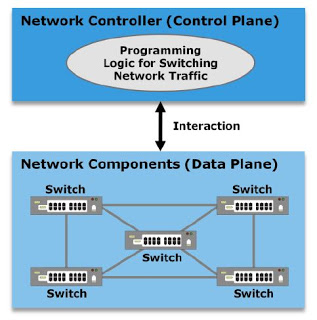Traditionally in any data center, a switch or a router consists of a data plane and a control plane. The function of the data plane is to transfer the network traffic from one physical port to another port by following rules that are programmed into the component. The function of the control plane is to provide the programming logic that the data plane follows for switching or routing of the network traffic.
Software Defined Networking Overview
As per EMC definition, Software-defined networking is an approach to abstract and separate the control plane functions from the data plane functions. Instead of the built-in control functions at the network components level, the software external to the components takes over the control functions.
The software runs on a compute system or a standalone device and is called network controller. The network controller interacts with the network components to gather configuration information and to provide instructions for data plane in order to handle the network traffic. The Software Defined Networking is
Also Read: Software Defined Storage Overview
Also Read: Software Defined Storage Overview
- Directly programmable: Network control is directly programmable because it is decoupled from forwarding functions.
- Agile: Abstracting control from forwarding lets administrators dynamically adjust network-wide traffic flow to meet changing needs.
- Centrally managed: Network intelligence is (logically) centralized in software-based SDN controllers that maintain a global view of the network, which appears to applications and policy engines as a single, logical switch.
- Programmatically configured: SDN lets network managers configure, manage, secure, and optimize network resources very quickly via dynamic, automated SDN programs, which they can write themselves because the programs do not depend on proprietary software.
- Open standards-based and vendor-neutral: When implemented through open standards, SDN simplifies network design and operation because instructions are provided by SDN controllers instead of multiple, vendor-specific devices and protocols.
The key advantages of Software-defined networking are
- Centralized control: The software-defined approach provides a single point of control for the entire SAN infrastructure that may span across data centers. The centralized control plane provides that programming logic for transferring the SAN traffic, which can be uniformly and quickly applied across the SAN infrastructure. The programming logic can be upgraded centrally to add new features and based on application requirements.
- Policy-based automation: With software-defined approach, many hardware-based SAN management operations such as zoning can be automated. Management operations may be programmed in the network controller based on business policies and best practices. This reduces the need for manual operations that are repetitive, error-prone, and time-consuming. Policy-based automation also helps to standardize the management operations.
- Simplified, agile management: The network controller usually provides a management interface that includes a limited and standardized set of management functions. With policy-based automation in place, these management functions are available in simplified form, abstracting the underlying operational complexity. This makes it easy to configure a SAN infrastructure. This also helps promptly modifying the SAN configuration to respond to the changing application requirements.
What Others are Reading Now...








0 Comment to "10.4 Software Defined Networking (SDN) Introduction"
Post a Comment